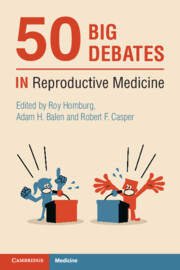Book contents
- 50 Big Debates in Reproductive Medicine
- Series page
- 50 Big Debates in Reproductive Medicine
- Copyright page
- Contents
- Contributors
- Foreword
- Introduction
- Section I Limits for IVF
- Section II IVF Add-ons
- Section III The Best Policy
- Section IV Embryology
- Section V Ethics and Statistics
- Section VI Male-factor Infertility
- Section VII Genetics
- Section VIII Ovarian Stimulation
- Section IX Hormones and the Environment
- 45A Metformin Is an Effective Treatment for Infertility Associated with Anovulatory PCOS
- 45B Metformin Is an Effective Treatment for Infertility Associated with Anovulatory PCOS
- 46A Laparoscopic Ovarian Drilling Should Be Performed for CC-Resistant PCOS
- 46B Laparoscopic Ovarian Drilling Should Be Performed for CC-Resistant PCOS
- 47A Asymptomatic Polycystic Ultrasound Appearance of the Ovary Is Favourable for IVF Outcome
- 47B Asymptomatic Polycystic Ultrasound Appearance of the Ovary Is Favourable for IVF Outcome
- 48A Ultrasound Monitoring Is Not Required for Letrozole Treatment
- 48B Ultrasound Monitoring Is Not Required for Letrozole Treatment
- 49A Progesterone Levels Should Be Measured on the Day of hCG Administration
- 49B Progesterone Levels Should Be Measured on the Day of hCG Administration
- 50A Progesterone Treatment Does Not Help Recurrent Miscarriage Patients
- 50B Progesterone Treatment Does Not Help Recurrent Miscarriage Patients
- 51A The Microbiome Environment Influences IVF Results
- 51B The Microbiome Environment Influences IVF Results
- Index
- References
48A - Ultrasound Monitoring Is Not Required for Letrozole Treatment
For
from Section IX - Hormones and the Environment
Published online by Cambridge University Press: 25 November 2021
- 50 Big Debates in Reproductive Medicine
- Series page
- 50 Big Debates in Reproductive Medicine
- Copyright page
- Contents
- Contributors
- Foreword
- Introduction
- Section I Limits for IVF
- Section II IVF Add-ons
- Section III The Best Policy
- Section IV Embryology
- Section V Ethics and Statistics
- Section VI Male-factor Infertility
- Section VII Genetics
- Section VIII Ovarian Stimulation
- Section IX Hormones and the Environment
- 45A Metformin Is an Effective Treatment for Infertility Associated with Anovulatory PCOS
- 45B Metformin Is an Effective Treatment for Infertility Associated with Anovulatory PCOS
- 46A Laparoscopic Ovarian Drilling Should Be Performed for CC-Resistant PCOS
- 46B Laparoscopic Ovarian Drilling Should Be Performed for CC-Resistant PCOS
- 47A Asymptomatic Polycystic Ultrasound Appearance of the Ovary Is Favourable for IVF Outcome
- 47B Asymptomatic Polycystic Ultrasound Appearance of the Ovary Is Favourable for IVF Outcome
- 48A Ultrasound Monitoring Is Not Required for Letrozole Treatment
- 48B Ultrasound Monitoring Is Not Required for Letrozole Treatment
- 49A Progesterone Levels Should Be Measured on the Day of hCG Administration
- 49B Progesterone Levels Should Be Measured on the Day of hCG Administration
- 50A Progesterone Treatment Does Not Help Recurrent Miscarriage Patients
- 50B Progesterone Treatment Does Not Help Recurrent Miscarriage Patients
- 51A The Microbiome Environment Influences IVF Results
- 51B The Microbiome Environment Influences IVF Results
- Index
- References
Summary
Aromatase enzyme is a microsomal cytochrome P450 hemoprotein-containing enzyme (the product of the CYP19 gene). It catalyzes the production of estrogens by conversion of androgens (androstenedione and testosterone) to estrone and estradiol in many tissues of the human body including the brain and ovaries. Extensive ultrasound monitoring of the letrozole-induced cycles is not required for either the number of follicles or endometrial thickness when standard dose of 2.5 or 5 mg is used based on our previous experience and many research studies, but at least minimal monitoring is mandatory for the particular group of women with PCOS especially when higher doses of letrozole are required.
- Type
- Chapter
- Information
- 50 Big Debates in Reproductive Medicine , pp. 249 - 250Publisher: Cambridge University PressPrint publication year: 2021

